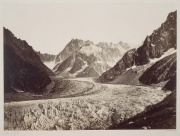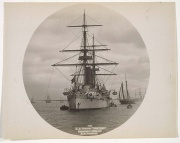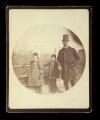Albumen paper
Description
A photographic printing-out paper widely used from about 1850-1890. Albumen paper was invented by Louis Desiré Blanquart and presented to the French Academy of Sciences in 1850. Blanquart used a thin layer of egg white protein to disperse and bind photosensitive salts. Egg white was whipped then allowed to settle to a liquid; this formed a homogeneous liquid which was mixed with small amounts of salt (usually Sodium chloride or Ammonium chloride) and Citric acid, then spread as a thin layer over a high quality cellulosic paper. After drying, the layer was activated by treatment with Silver nitrate to form Silver chloride, a light sensitive compound. To create an image, a negative was placed in direct contact with the paper, then exposed to daylight. Once the development was complete, it was stopped by treating the paper with a fixing agent such as Sodium thiosulfate. Albumen prints were a golden to purplish brown color with a glossy surface. It was replaced in the 1890s by Silver gelatin paper.
Synonyms and Related Terms
albumen prints
Additional Information
Timothy Vitale, Paul Messier, "Physical and Mechanical Properties of Albumen Photographs" JAIC 33(3):279-99, 1994.
Comparisons
Additional Images
Authority
- E.J.LaBarre, Dictionary and Encyclopedia of Paper and Paper-making, Swets & Zeitlinger, Amsterdam, 1969 Comment: dates of use = 1850-1890
- The Dictionary of Art, Grove's Dictionaries Inc., New York, 1996 Comment: final date of use = 1895
- Luis Nadeau, Encyclopedia of Printing, Photographic, and Photomechanical Processes, Atelier, New Brunswick, 1997 Comment: Invented by Louis Desire Blanquart in the late 1840s and presented to the French Academy of Sciences on May 27, 1850.
- Caring for your Collections, Arthur W Schulz (ed.), Harry N. Abrams, Inc. , New York, 1992 Comment: Debbie Hess Norris chapter; dates of use = 1855-1885
- Website address 1 Comment: Preservation 101 Glossary of Terms -invented in 1850 by Louis-Desire Blanquart-Evrard










